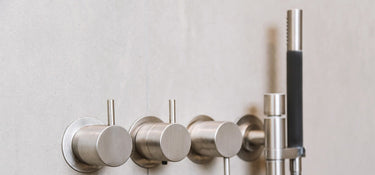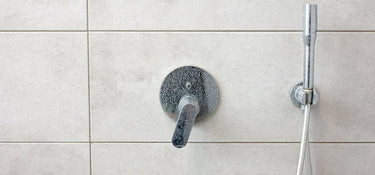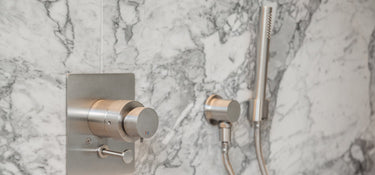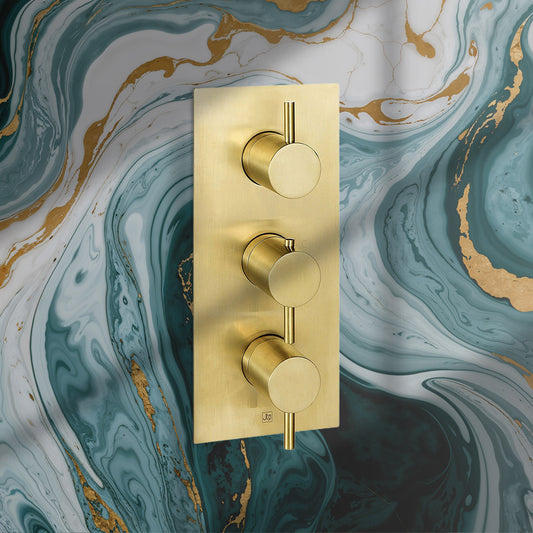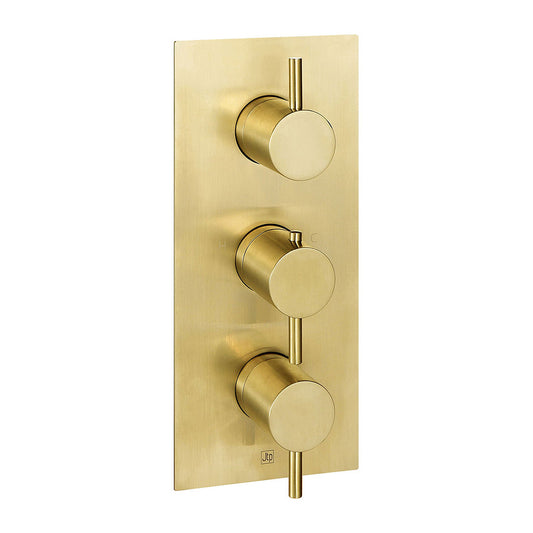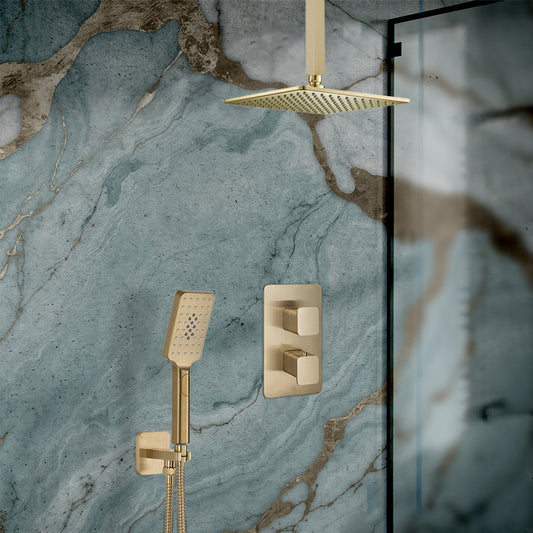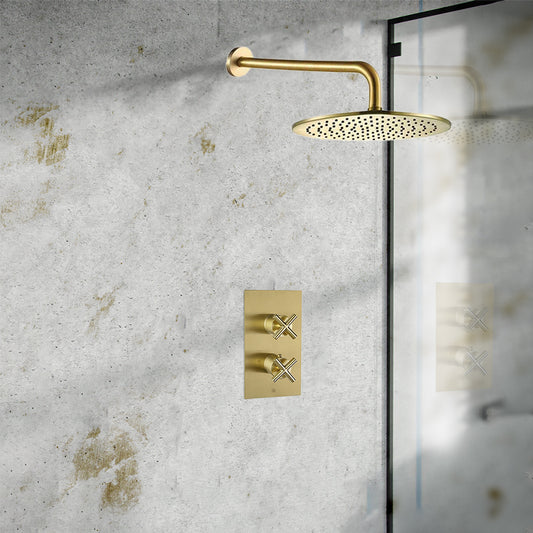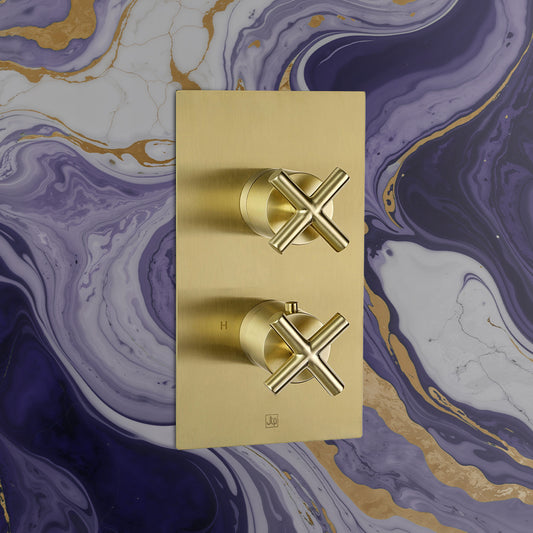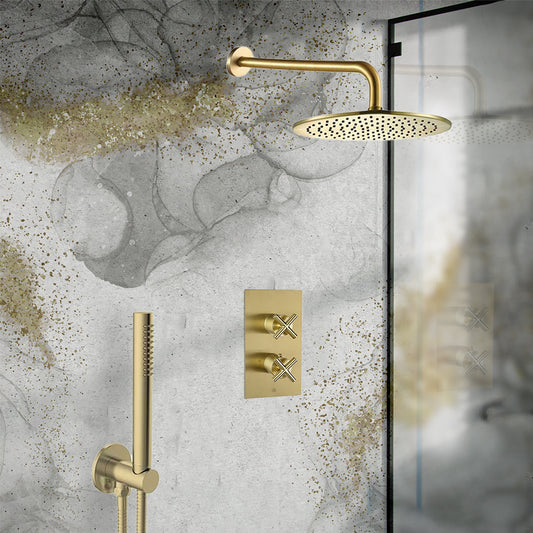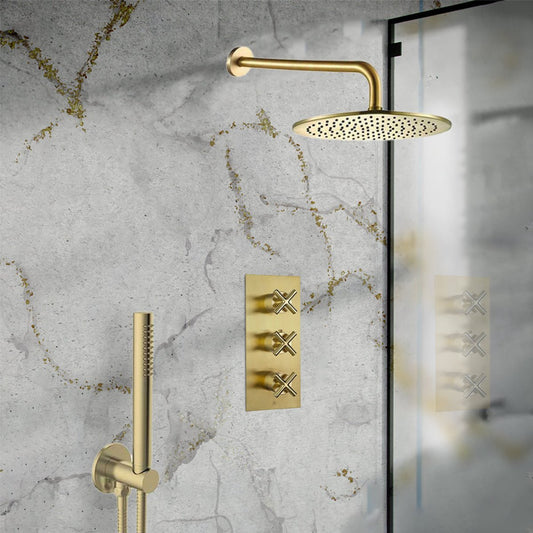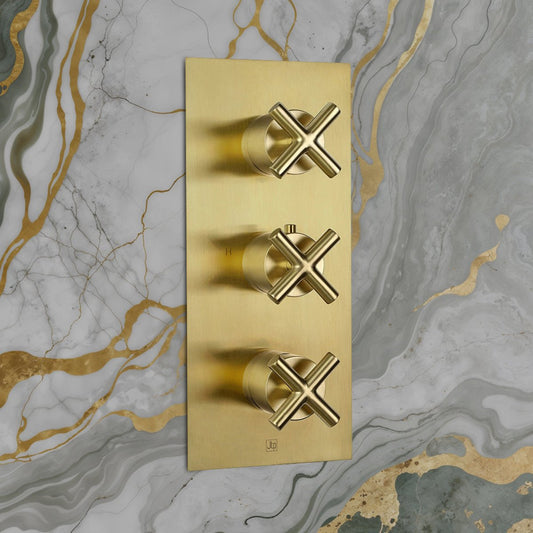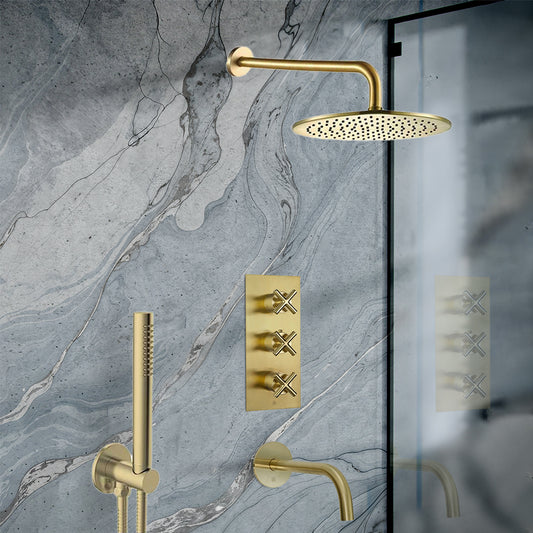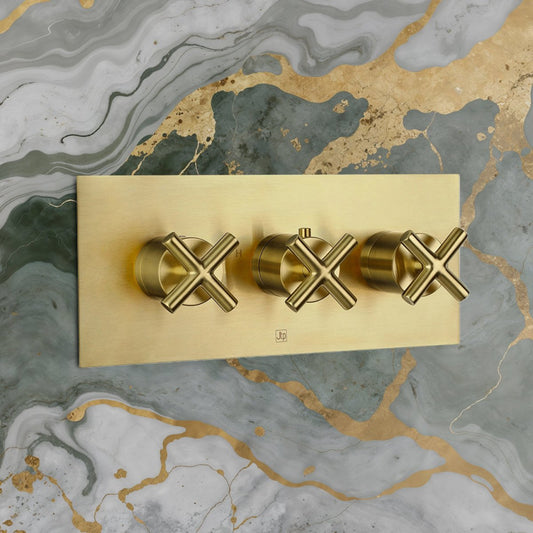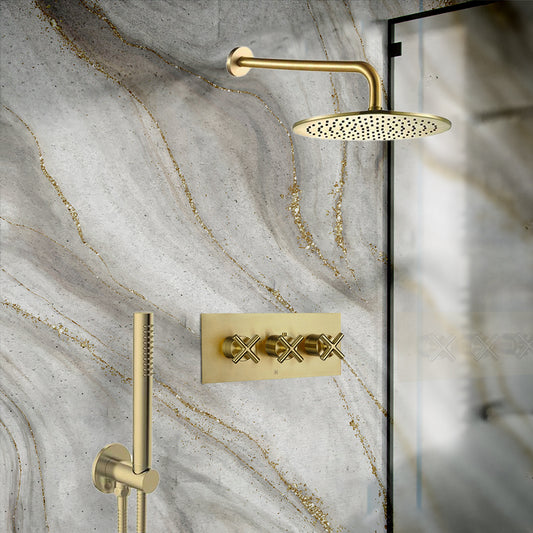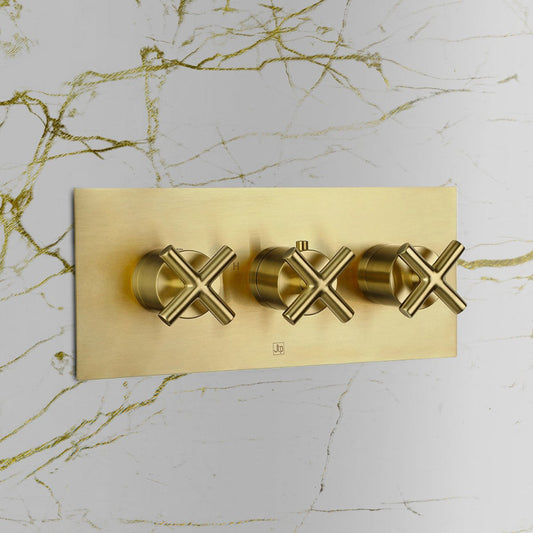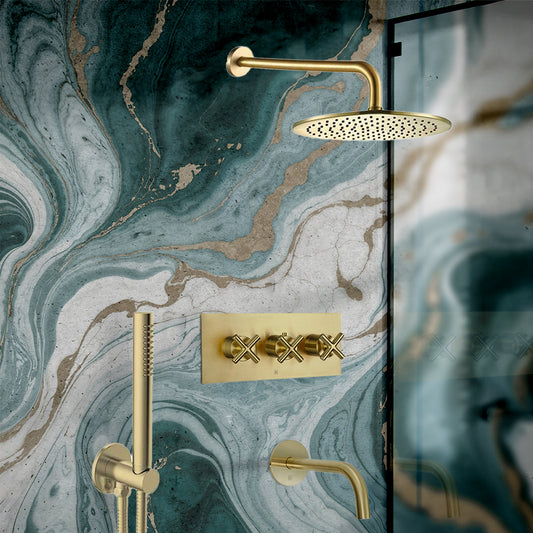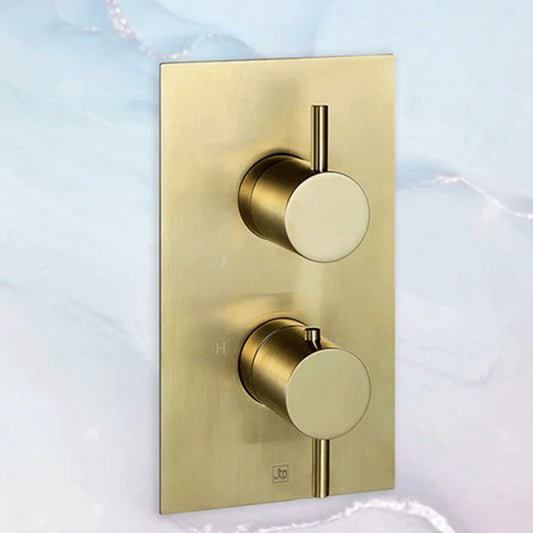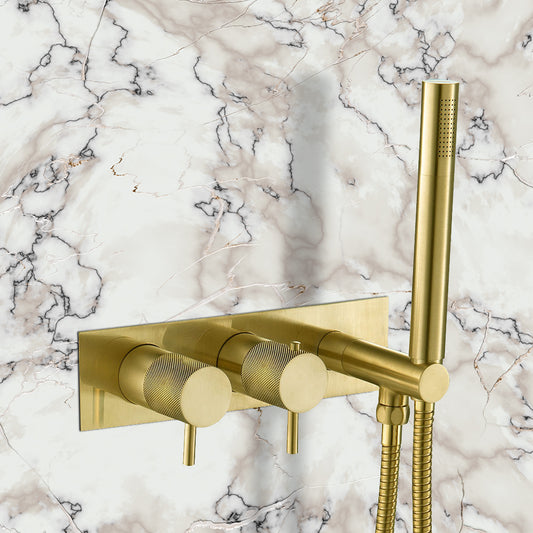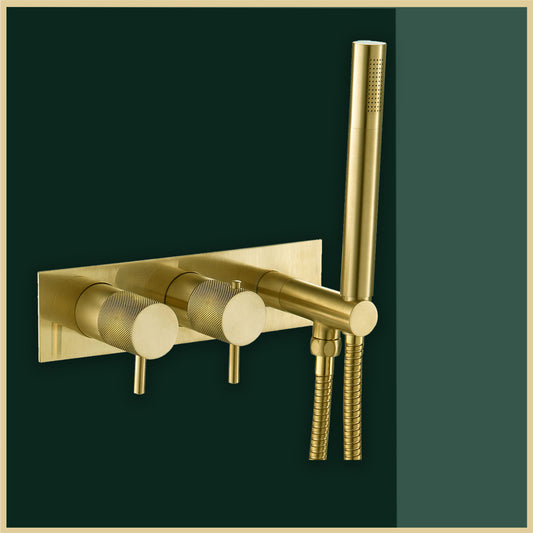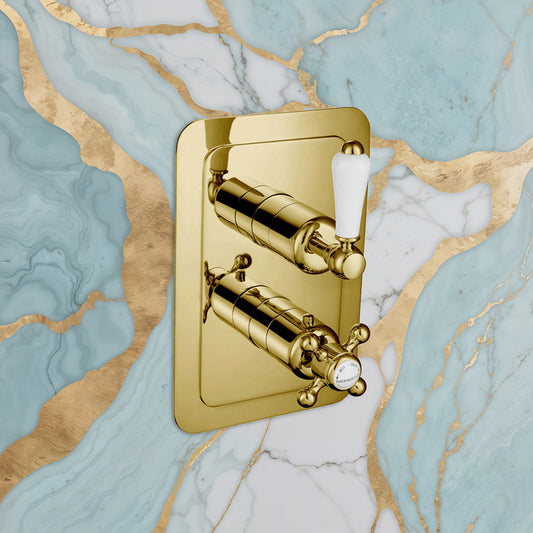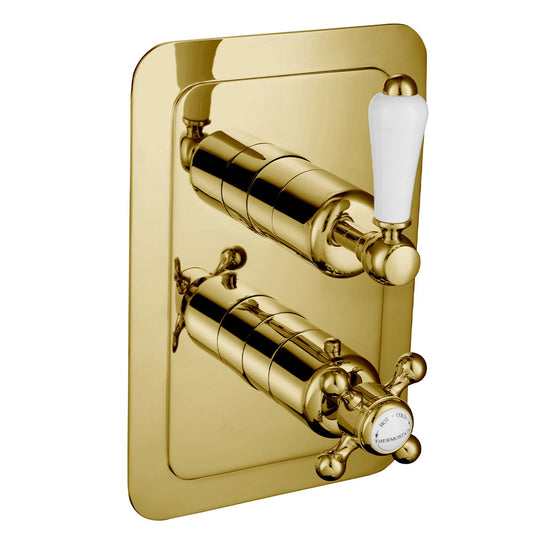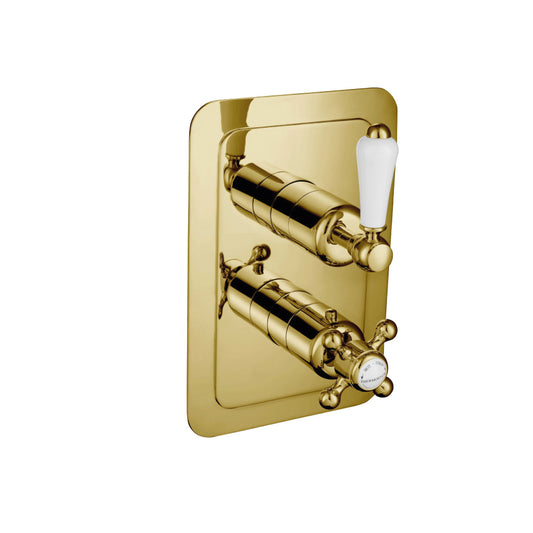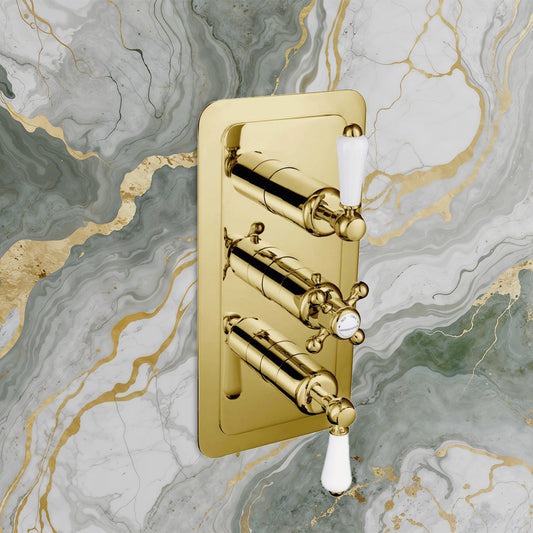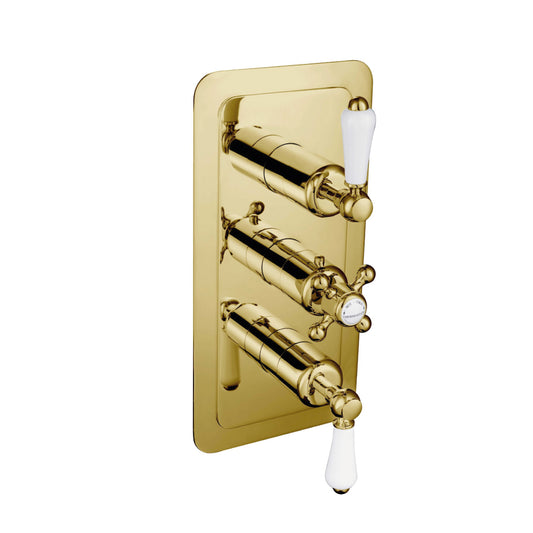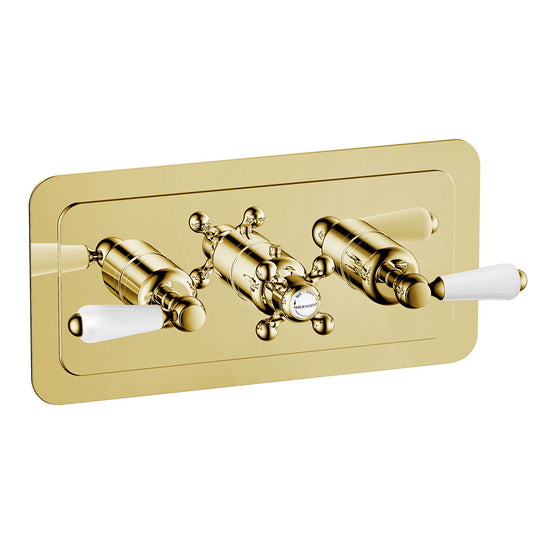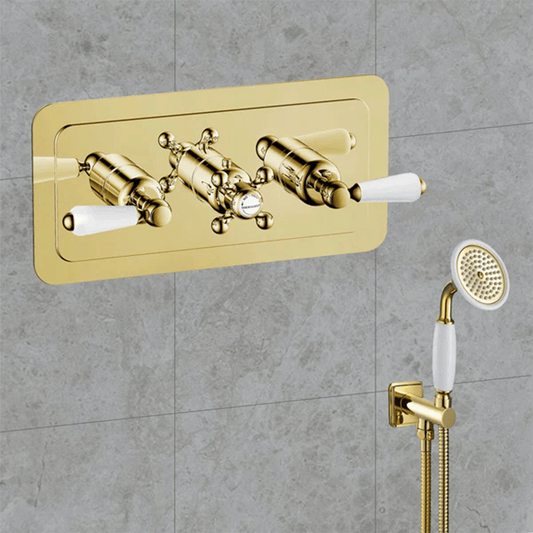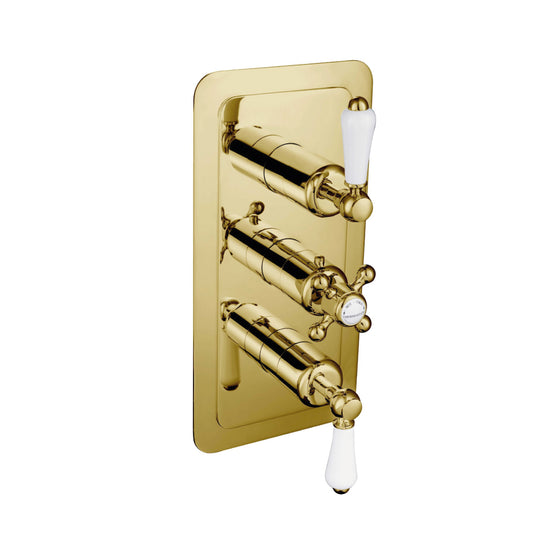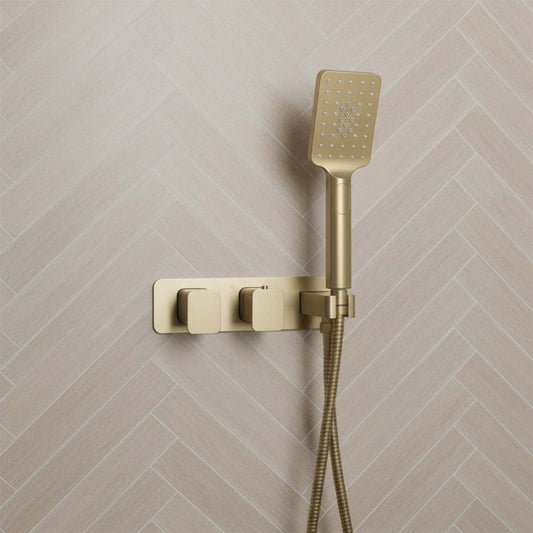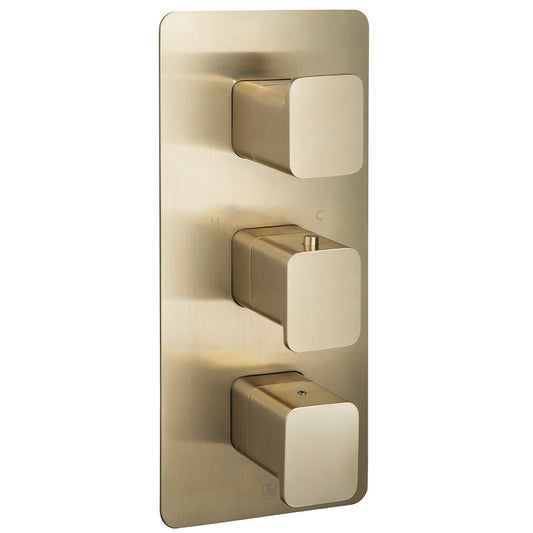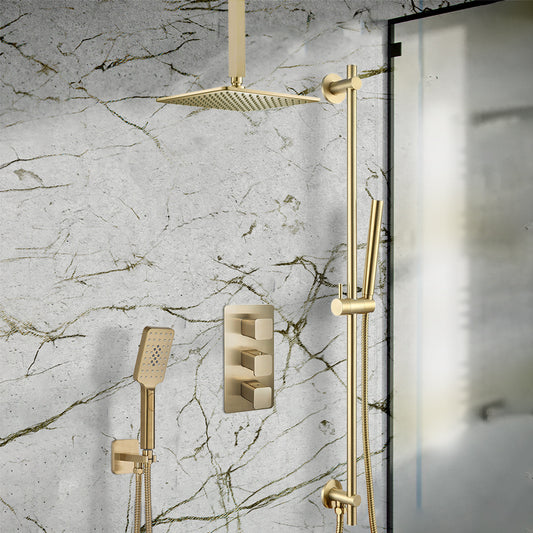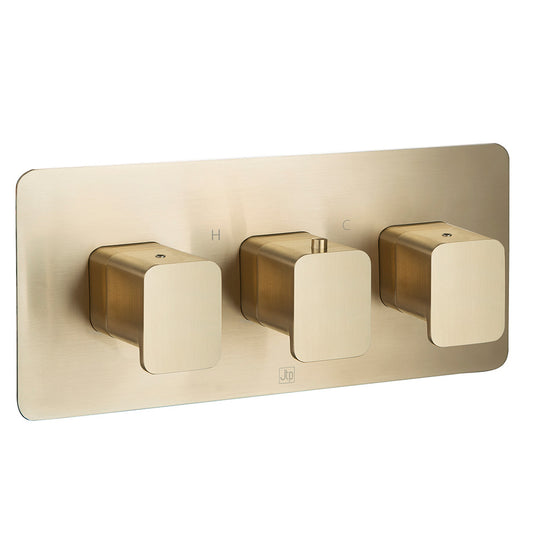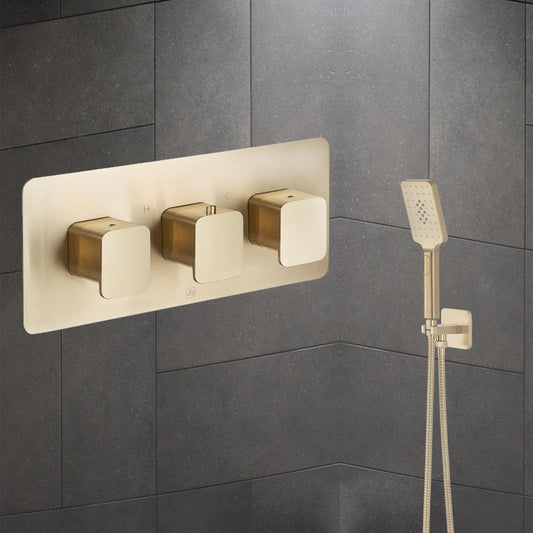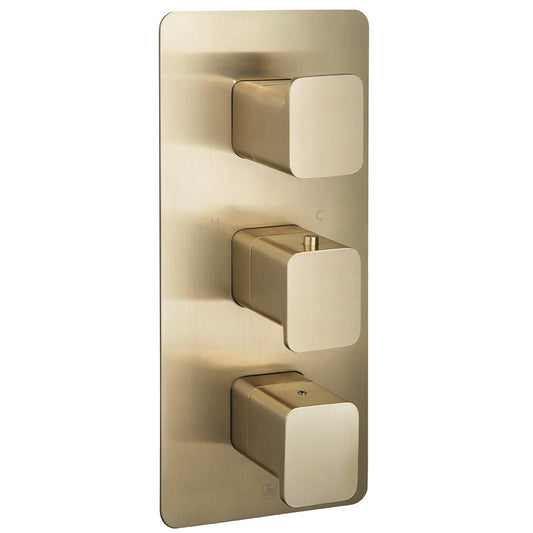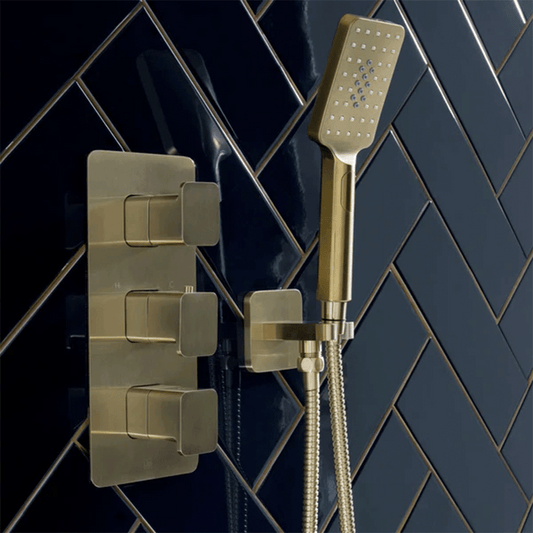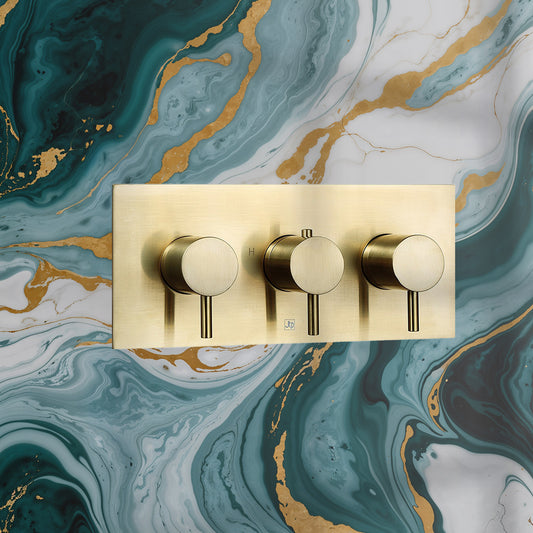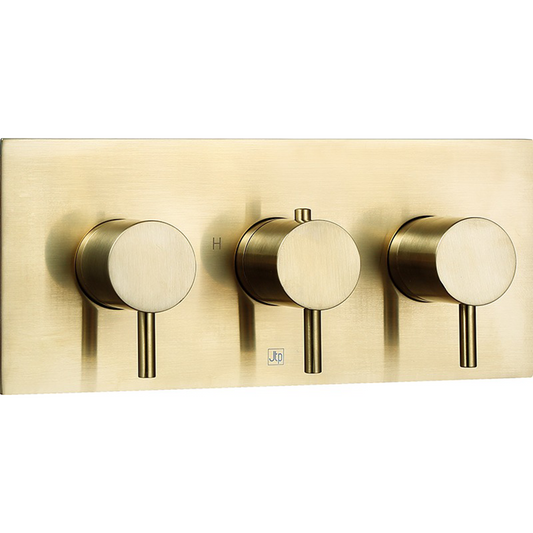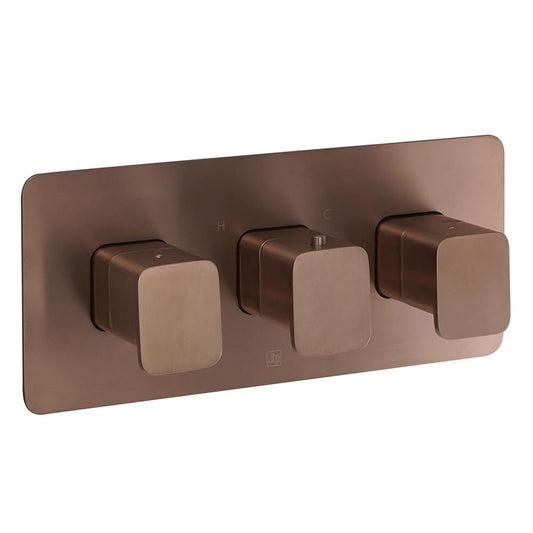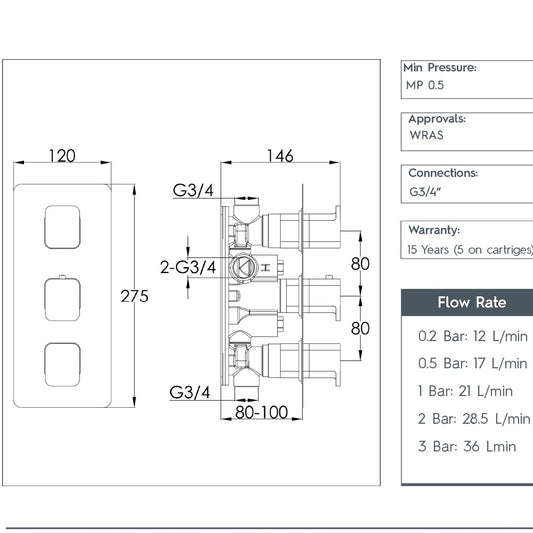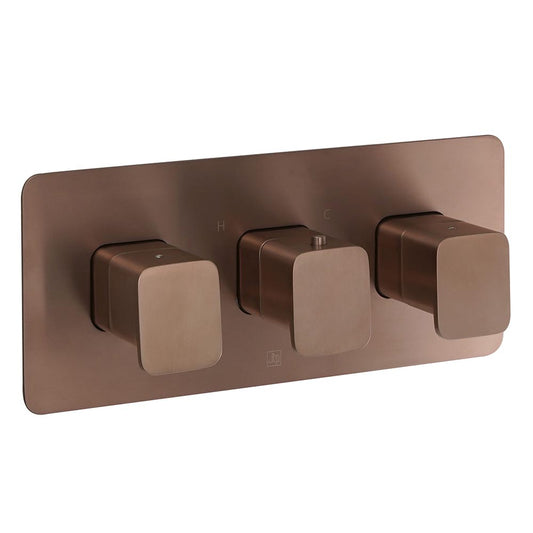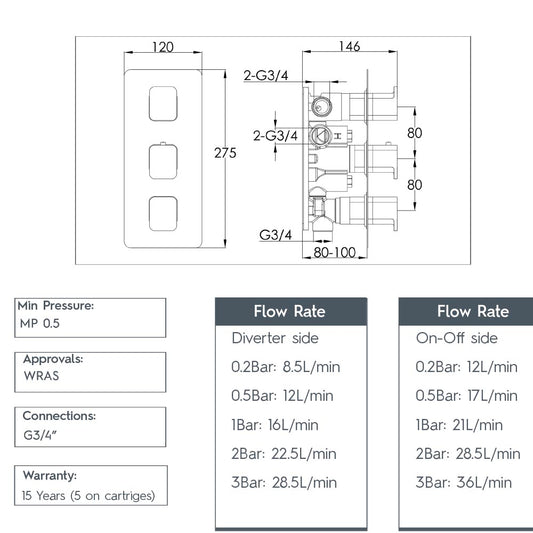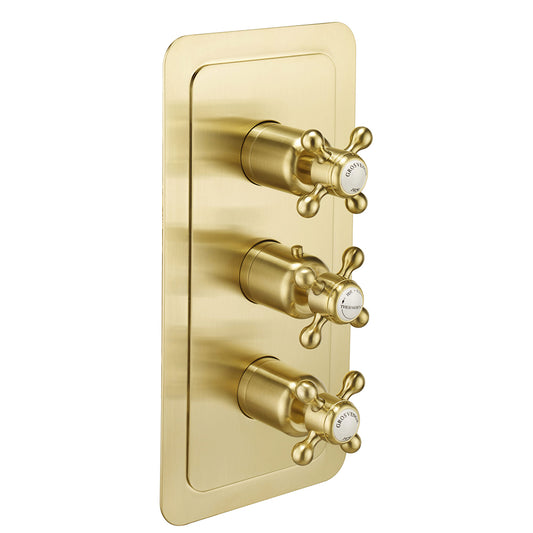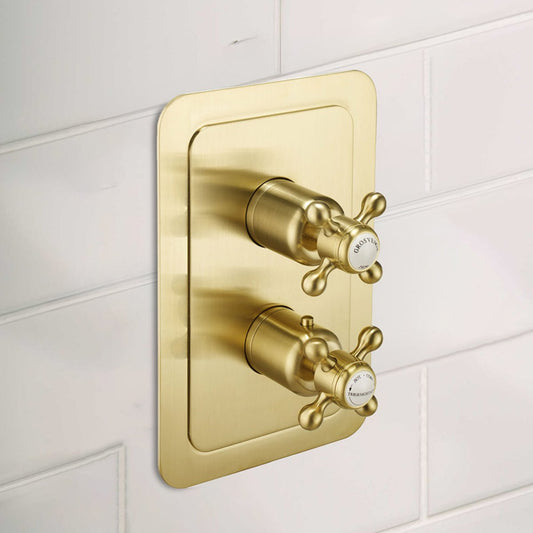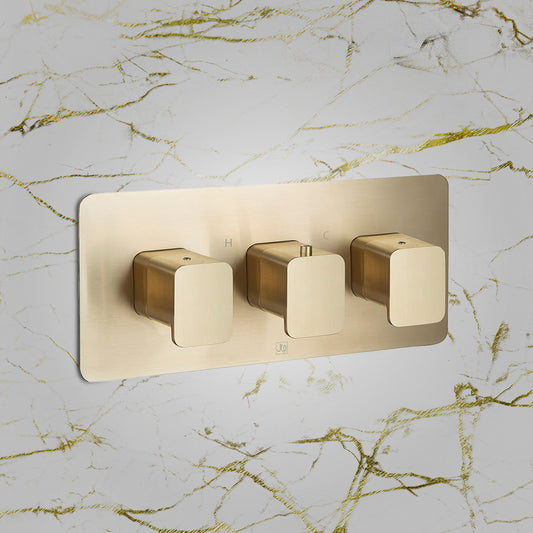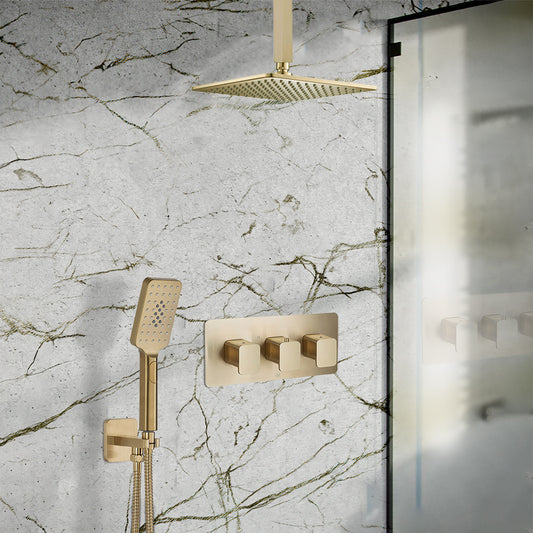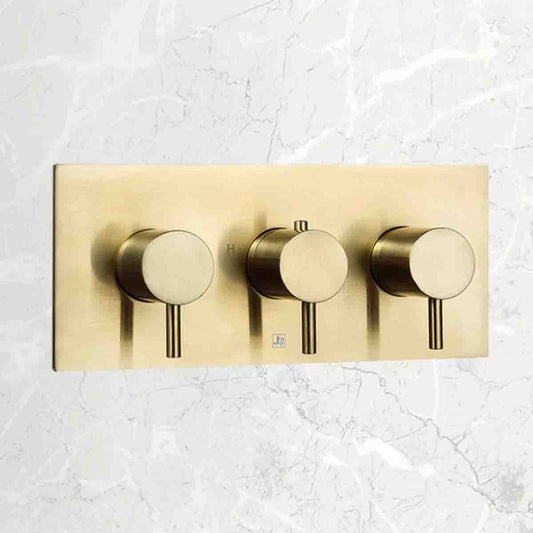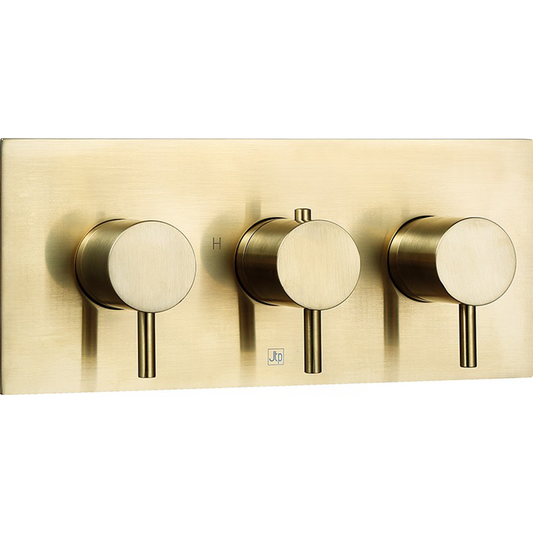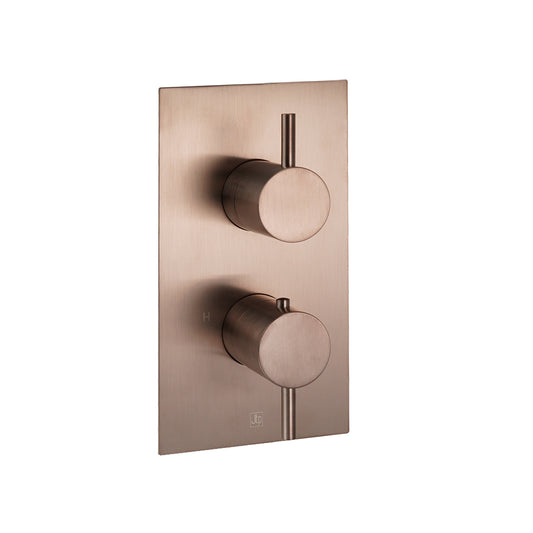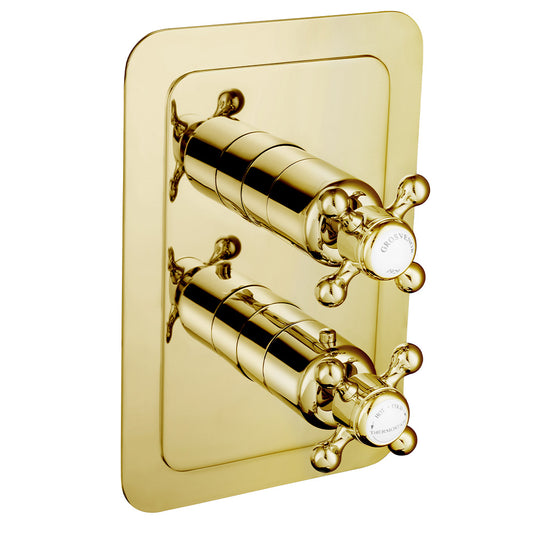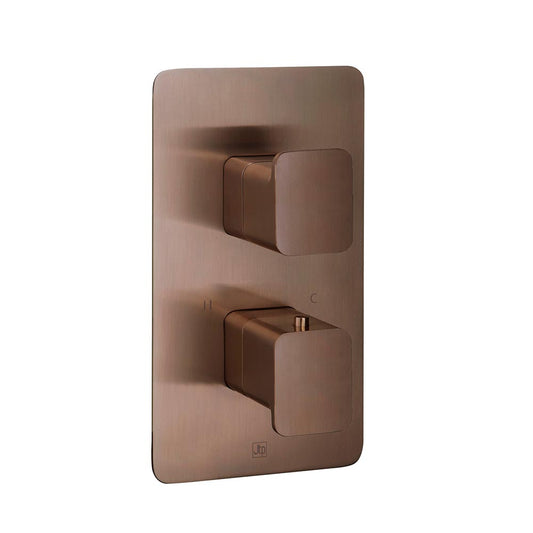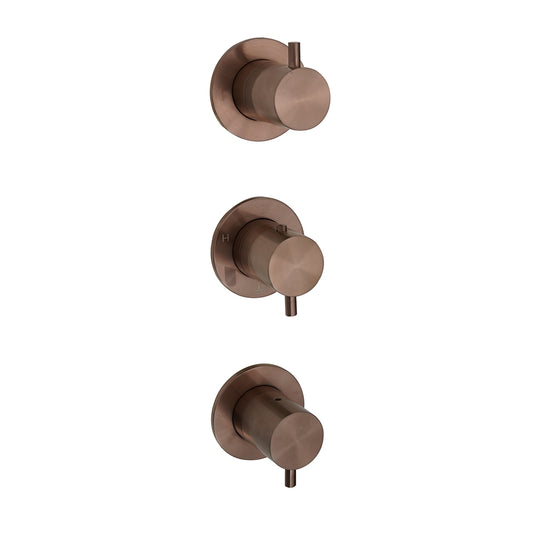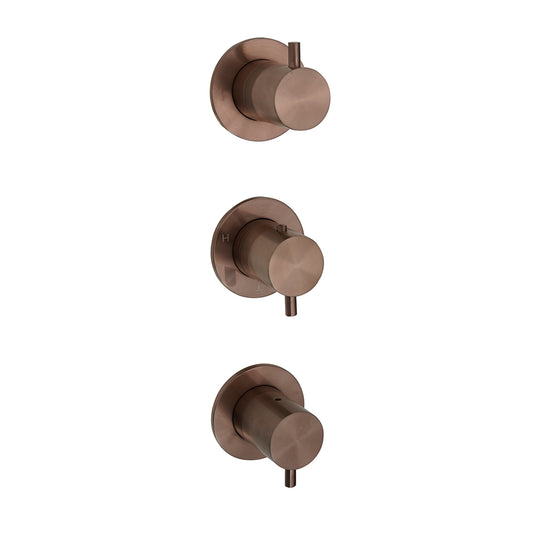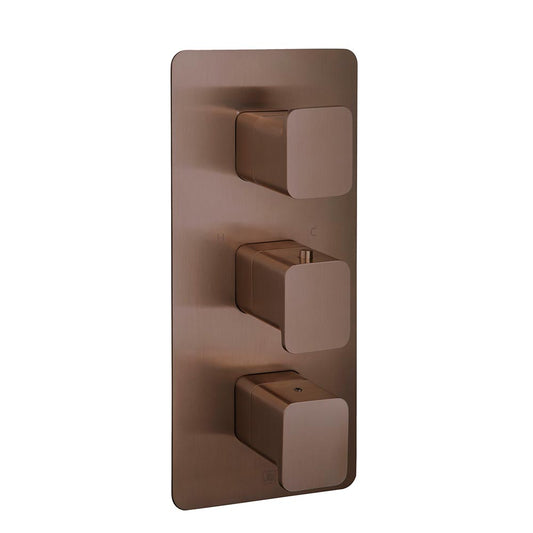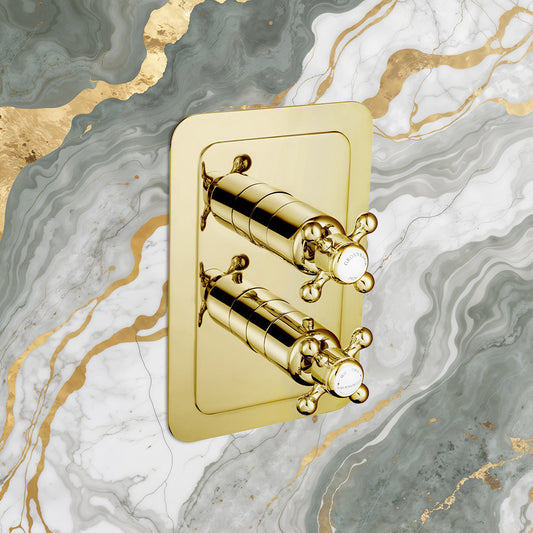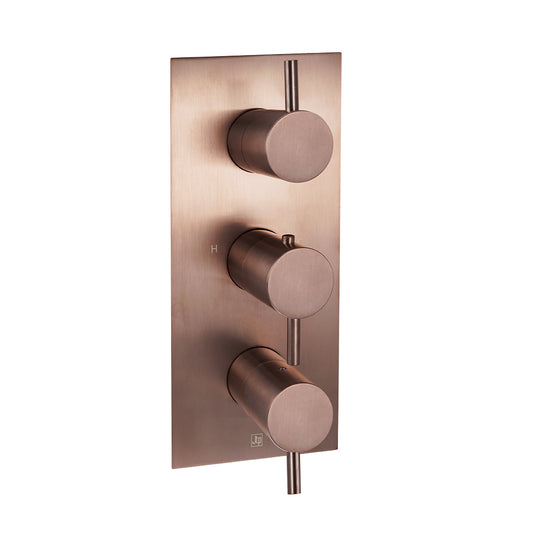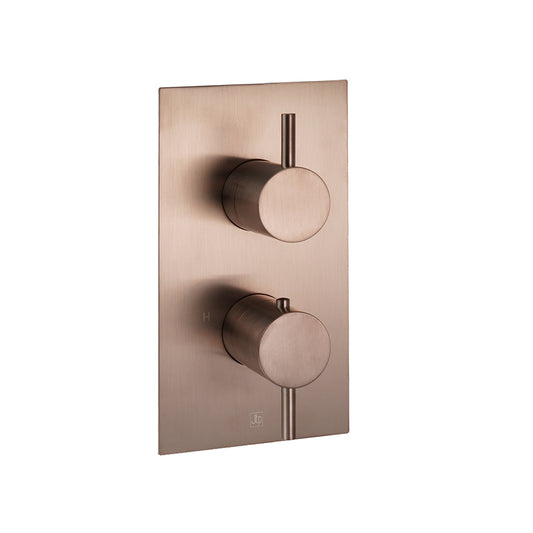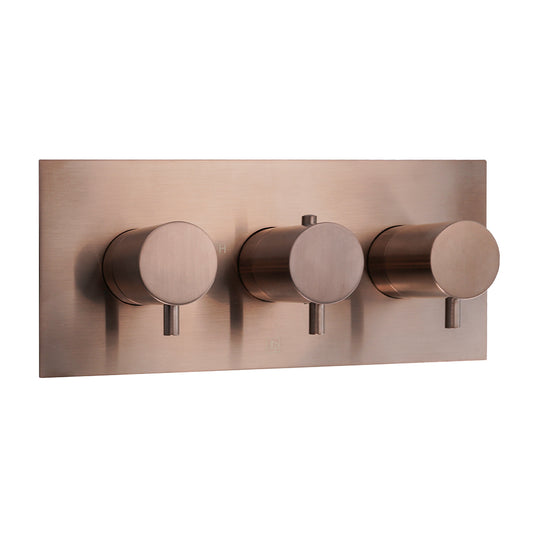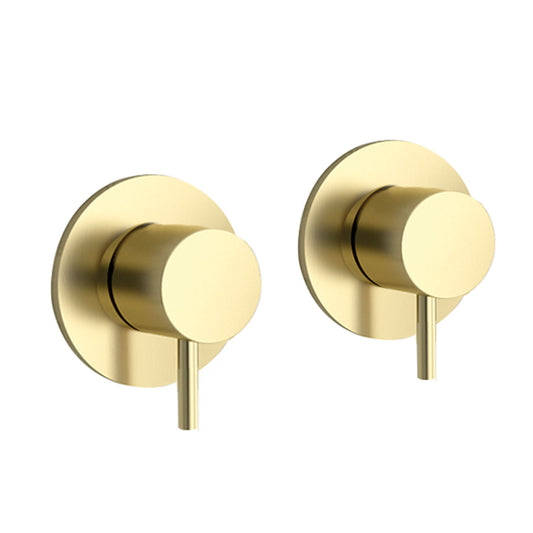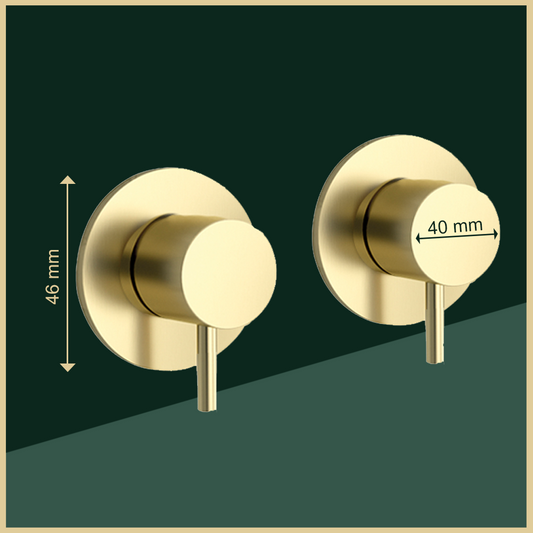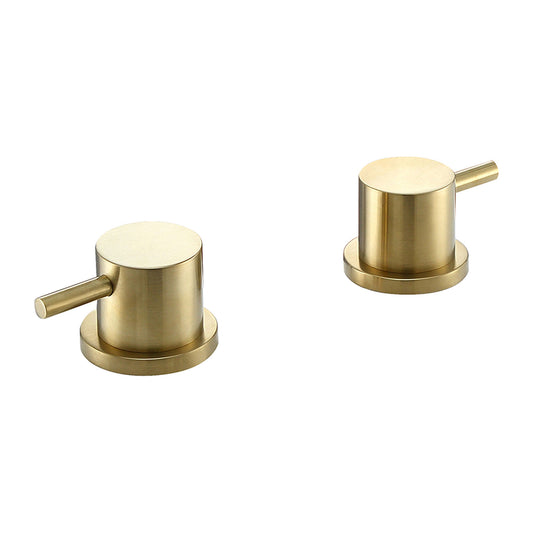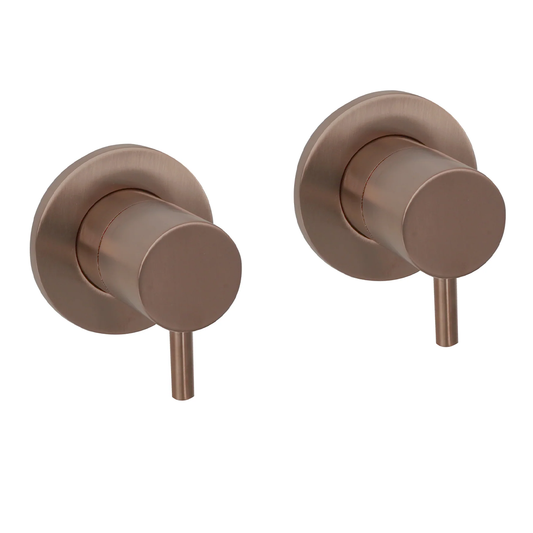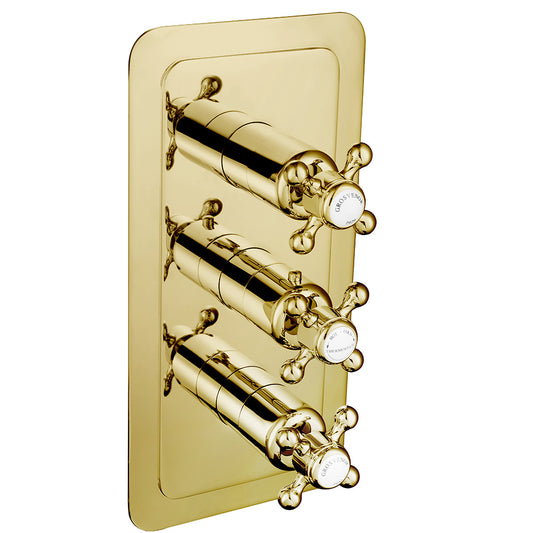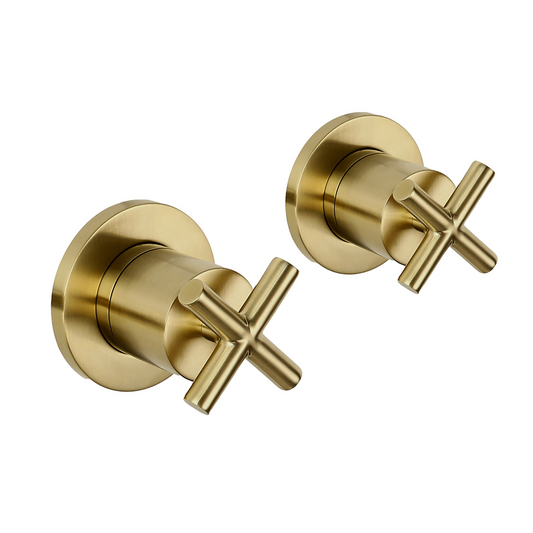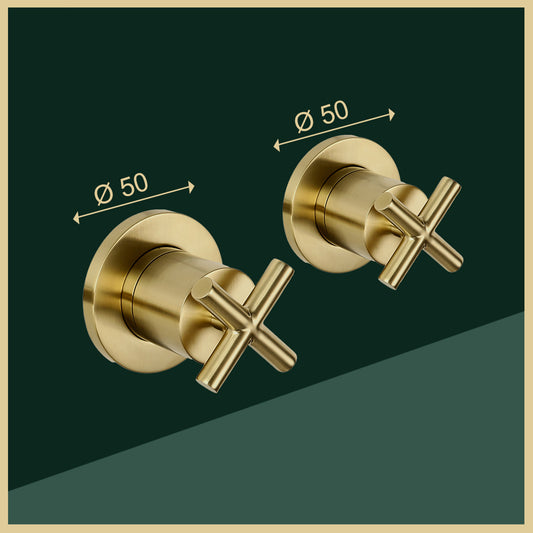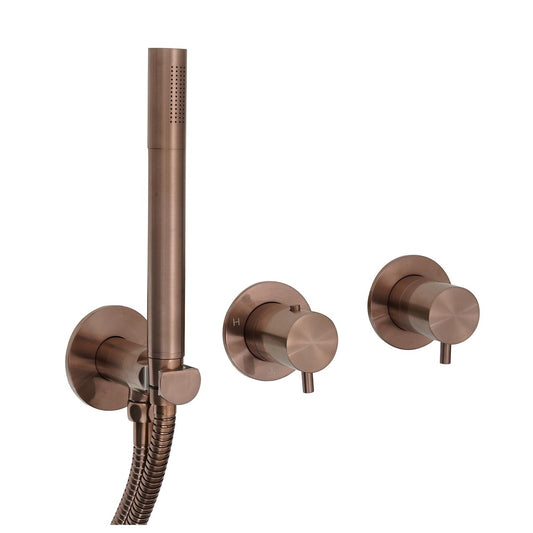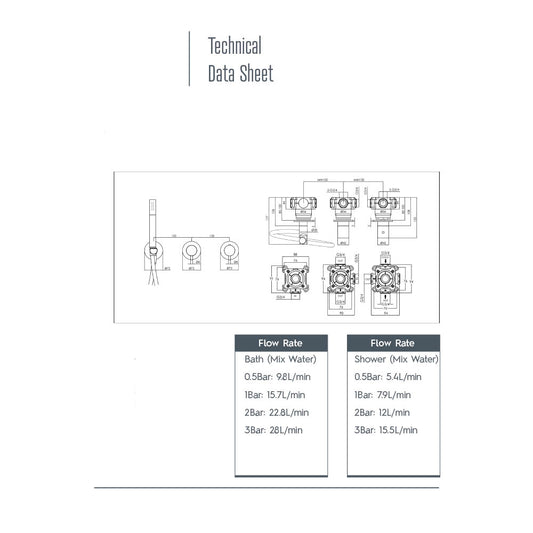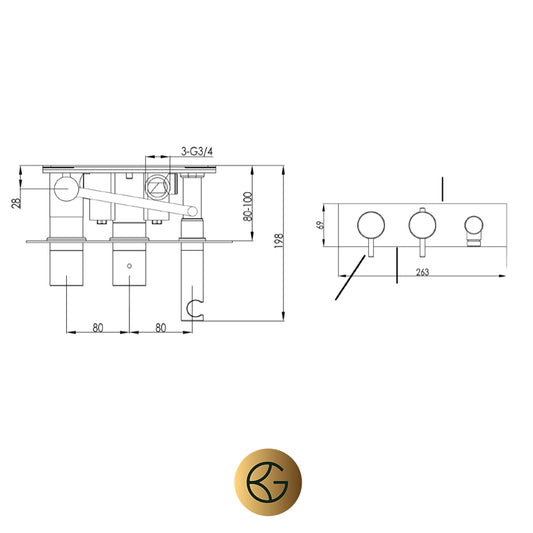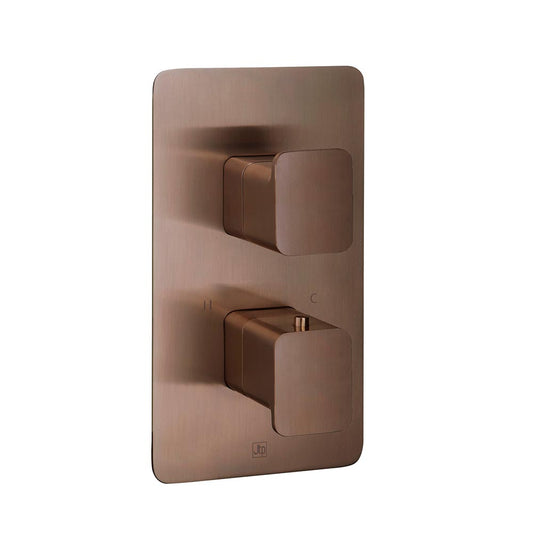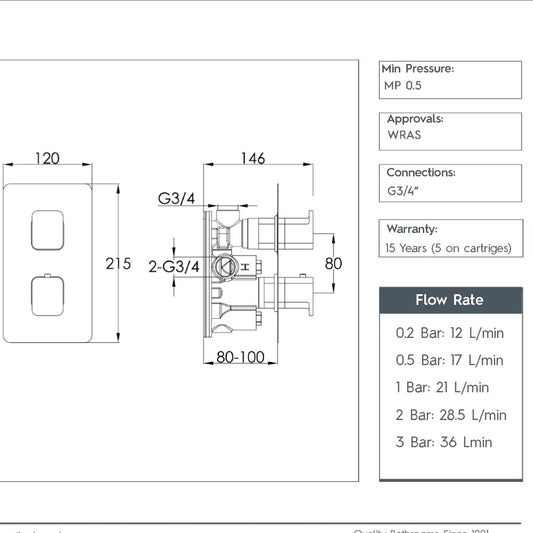Shopping for the Best Thermostatic Shower Valves ? Know These 7 Points Before You Buy!
Table Of Contents:
-
Buyer’s Guide to Top Shower Valves—What You Need to Know Before You Buy
→ -
Concealed Thermostatic Shower Valves Collection
→ -
Understanding Shower Mixer Valves
→ -
Types of Shower Mixer Valves
→ -
Installation and Space Efficiency
→ -
Choosing the Right Design
→ -
Non-Return Shower Valves
→ -
Budget-Friendly Options
→ -
Maintenance and Cleaning
→ -
Water Pressure and Inlet Spacing
→ -
Shower Valve Technology and Features
→ -
Manual vs. Thermostatic Valves
→ -
Conclusion
→
Buyer’s Guide to Top Shower Valves—What You Need to Know Before You Buy
Finding the perfect shower valve can transform your daily routine from mundane to luxurious. Whether you’re renovating your space or simply upgrading, this blog will equip you with essential knowledge on selecting the ideal valve that blends functionality with aesthetics.
You’ll learn about the different types of shower valves, from manual to digital, and understand how they impact water flow, temperature control, and overall bathroom design. Get excited to discover detailed insights into cutting-edge technologies and design options that will help you make a smart, stylish choice for your next bathroom upgrade.
Understanding Shower Mixer Valves
Shower mixer valves are designed to regulate both water flow and temperature simultaneously. These valves come in various styles and functionalities, influencing how well they integrate into your bathroom design and meet your practical needs. By adjusting the handle or dial, you can achieve the desired water temperature and flow rate. This versatility makes shower mixer valves a popular choice for many homeowners, as they offer a balance of control and convenience. Choosing the right mixer valve can enhance the overall aesthetic of your bathroom while ensuring a comfortable and efficient shower experience.

Types of Shower Mixer Valves
Concealed Shower Valves
Concealed shower valves are designed to be hidden behind the wall, with only the controls exposed. This type of valve offers a sleek and modern look, which is ideal for contemporary bathroom designs. The primary appeal of concealed valves is their minimalist appearance, contributing to a clean and uncluttered bathroom space. They typically feature a single control panel or knobs that allow users to manage water temperature and flow, while the actual valve mechanism is concealed behind the wall.
Installation of concealed shower valves requires careful planning and potentially significant modification to the wall. This involves creating a cavity within the wall to house the valve and ensuring that the plumbing connections are correctly aligned. While this installation process can be more complex and costly compared to exposed valves, the resulting aesthetic is often worth the investment for those seeking a high-end, modern bathroom design. Concealed valves are particularly suitable for creating a seamless and sophisticated look in luxury bathrooms.
Exposed Shower Valves
Exposed shower valves are mounted on the surface of the bathroom wall and are visible as part of the overall design. These valves come in various styles, from sleek modern designs to traditional lever-operated controls. The visibility of exposed valves makes them a prominent feature in the bathroom, and they are available in numerous finishes and designs, allowing for greater customization to match different bathroom aesthetics.
One of the key advantages of exposed shower valves is their straightforward installation. Unlike concealed valves, exposed models do not require extensive wall modifications, making them a more accessible and budget-friendly option. They are typically easier to replace or repair due to their visible nature, and they offer a variety of designs that can fit into various styles, whether it’s a contemporary, industrial, or classic look. This type of valve is also generally easier to maintain and clean, as all components are easily accessible.
Thermostatic Mixer Valves
Thermostatic mixer valves are designed to provide precise control over water temperature, ensuring a consistent and safe shower experience. These valves use advanced technology to automatically adjust the water flow and maintain a steady temperature, even when there are fluctuations in the water supply. This makes them particularly useful in households with young children or elderly members, as they help prevent sudden changes in water temperature that could cause discomfort or burns.
The operation of thermostatic valves involves a control mechanism that maintains the set temperature by adjusting the mix of hot and cold water. These valves often feature multiple handles or digital controls that allow users to set their preferred temperature and flow rate. Thermostatic valves are known for their high level of safety and convenience, making them a popular choice in modern bathrooms where precise temperature control is valued. The advanced technology also contributes to energy efficiency by reducing water waste.
Manual Shower Valves
Manual shower valves are characterized by their simple operation, where users manually adjust the handles or dials to control the water flow and temperature. These valves offer a direct and straightforward approach to managing the shower, making them easy to use and understand. The simplicity of manual valves means there are fewer components to break or malfunction, resulting in lower maintenance and repair costs.
Despite their basic functionality, manual shower valves are effective for many users who prefer a more traditional method of controlling their shower. They are often less expensive than thermostatic or digital valves, making them a cost-effective option for those who do not require advanced temperature control features. However, manual valves may lack the precision and consistency of more advanced models, which can be a consideration for those who prioritize temperature stability.
Push-Button Shower Valves
Push-button shower valves feature an on/off mechanism operated by pressing buttons. These valves offer a modern, interactive approach to controlling the shower, with multiple buttons that can be programmed for different settings. Push-button valves often include features like preset temperatures and flow rates, allowing users to customize their shower experience with ease.
The convenience of push-button valves lies in their user-friendly interface and customizable settings. They provide a contemporary look and often come with various options for adjusting water flow and temperature. This type of valve is ideal for those who enjoy having multiple settings and a high degree of control over their shower experience. However, the complexity of push-button controls can sometimes lead to issues if the buttons malfunction, so regular maintenance is necessary to ensure smooth operation.
Diverter Shower Valves
Diverter shower valves are designed to direct water flow to different outlets within the shower system. These valves allow users to switch between various water sources, such as a handheld showerhead, overhead rain shower, or body jets. Diverter valves come in multiple configurations, including 2-way, 3-way, 4-way, and 5-way options, depending on the number of outlets they can control.
The primary advantage of diverter valves is their ability to manage multiple features in a complex shower system. They offer flexibility and convenience, allowing users to easily switch between different shower components based on their preferences. Diverter valves are ideal for large, luxurious showers with multiple outlets, providing a high level of customization and control over the shower experience.
Digital Shower Valves
Digital shower valves represent the latest advancements in shower technology, offering programmable settings and wireless controls. These valves often include features such as touchscreens, LED lighting, and smart controls that allow users to adjust temperature and water flow with precision. Digital shower valves can be programmed to remember preferred settings and offer a high level of convenience and customization.
The integration of digital technology into shower valves provides a luxurious and high-tech experience. Users can control their shower settings with ease, using remote controls or mobile apps to adjust temperature and flow. Digital valves also contribute to energy efficiency by providing precise control over water usage, and their sleek, modern design enhances the overall aesthetic of contemporary bathrooms. The advanced features of digital valves make them a popular choice for those who seek the latest in bathroom technology and comfort.
Installation and Space Efficiency
Concealed Shower Valves:
Concealed shower valves are installed behind the wall, creating a clean and minimalist look by hiding all the plumbing elements. This design is ideal for modern bathrooms where a streamlined appearance is desired. However, the installation of concealed valves is more complex and typically requires alterations to the wall structure. This might involve cutting into the wall to fit the valve and making sure that all components are properly sealed and aligned. If you’re undertaking a major renovation or building a new bathroom, this type of installation can be ideal as it allows for a more customized layout and a sleek appearance. However, if you're retrofitting an existing bathroom, the process can be invasive and may require professional help to ensure everything is done correctly.
Exposed Shower Valves:
Exposed shower valves, on the other hand, are mounted directly onto the wall, making them easier and more cost-effective to install. This type is especially practical for smaller bathrooms or when updating an existing setup without extensive renovations. Exposed valves are more visible and can be found in various designs, from contemporary bar styles to traditional lever controls. Their installation is less disruptive as it does not require modifications to the wall. However, their appearance is less streamlined compared to concealed valves, and they may take up more visual space on the wall. For homeowners looking for a straightforward update with minimal changes, exposed shower valves offer a practical and budget-friendly option.
Space Considerations:
The choice between concealed and exposed valves also depends on the available space in your bathroom. Concealed valves help save visual space and contribute to a more spacious and uncluttered look. They are particularly beneficial in smaller bathrooms where every inch counts. Exposed valves, while easier to install, might occupy more wall space and can affect the overall layout of your bathroom. When planning the installation, consider how much space each type will occupy and how it will impact the functionality and aesthetics of your bathroom.
Installation Requirements:
Proper installation is crucial for both types of valves to ensure they function correctly and prevent issues such as leaks. Concealed valves typically require professional installation due to the complexity of fitting them behind the wall and ensuring proper sealing. Exposed valves, while easier to install, still need to be securely mounted and aligned correctly with your shower fixtures to avoid any operational issues. Regardless of the type, it's essential to follow installation guidelines closely and ensure that all connections are secure to maintain the performance and durability of your shower system.

Choosing the Right Design
Design Integration:
Choosing the right design for your shower valve is essential for ensuring that it complements the overall aesthetic of your bathroom. The valve should harmonize with your bathroom's existing fixtures and décor to create a cohesive look. For a contemporary bathroom, sleek and minimalist valve designs work well, often featuring simple lines and modern controls. These designs enhance the clean, uncluttered appearance that characterizes modern spaces. In contrast, traditional and Victorian bathrooms benefit from more classic and ornate designs, which can add a touch of historical charm and elegance to the space.
Design Styles:
1. Contemporary: In contemporary bathrooms, the focus is on sleek, high-tech designs that emphasize simplicity and functionality. Shower valves with minimalist designs, such as those with smooth, clean lines and modern finishes, fit well with this style. Features such as digital controls and high-tech interfaces can further enhance the contemporary aesthetic, providing both form and function.
2. Traditional: Traditional bathrooms often feature more detailed and ornate valve designs. Classic lever controls and detailed finishes, such as polished brass or chrome, are common in this style. These valves complement other traditional elements in the bathroom, creating a cohesive and nostalgic ambiance.
3. Victorian: Victorian-style bathrooms are known for their intricate details and luxurious finishes. Shower valves in this style often include elaborate designs and decorative elements that match the grandeur of Victorian décor. Choosing valves with ornate handles and detailed patterns can help achieve a cohesive look that resonates with the period’s opulence.
Functionality vs. Aesthetics:
While aesthetics are important, the functionality of the shower valve should not be overlooked. It’s essential to select a valve that not only looks good but also meets your practical needs. Thermostatic valves, for example, offer precise temperature control and safety features, making them a great choice for families or those who value consistent water temperature. Manual valves provide a more straightforward approach but may lack the temperature stability of thermostatic options. The right balance between design and functionality ensures that your shower valve enhances both the look and performance of your bathroom.
Personal Preferences:
Ultimately, your choice of shower valve design should reflect your personal style and preferences. Whether you prefer the sleek, high-tech appeal of modern designs or the classic charm of traditional fixtures, selecting a valve that aligns with your aesthetic tastes will enhance your enjoyment of the bathroom. A well-chosen design not only complements your bathroom’s décor but also ensures that you’re satisfied with its functionality and appearance over time.
Non-Return Shower Valves
Non-return shower valves are a crucial component in modern plumbing systems, designed to prevent the backflow of water into your home's supply lines. These valves serve as a safeguard against potential flooding and contamination by ensuring that water only flows in one direction. They are particularly important in maintaining the safety and efficiency of your shower system by stopping any possibility of water flowing back into the plumbing system, which can occur due to changes in water pressure or faulty fixtures.
Installing a non-return valve in your shower setup helps to protect against water damage and maintain the integrity of your plumbing system. These valves are especially beneficial in areas where water pressure fluctuations are common, as they provide an added layer of protection against potential leaks and contamination. By incorporating non-return valves, you can ensure a reliable and safe shower experience, safeguarding both your home and the quality of your water supply.
Budget-Friendly Options
When shopping for shower valves, budget-friendly options can provide a balance between cost and functionality without compromising quality. Exposed shower valves are often a more affordable choice compared to concealed models. These valves are mounted directly on the wall and are visible, which typically results in lower installation costs and a simpler setup. Exposed valves come in various designs, including modern bar styles and traditional lever controls, offering a range of aesthetic choices to fit different bathroom themes.
Additionally, manual shower valves are generally less expensive than thermostatic or digital models. They provide straightforward control over water flow and temperature through simple handles or dials. While manual valves may lack the advanced features of higher-end options, they can be a cost-effective solution for those who prefer basic functionality and are working within a tight budget. Balancing budget constraints with desired features involves evaluating different valve types and choosing the best option that meets both your financial and practical needs.
Maintenance and Cleaning
Proper maintenance and cleaning are essential for ensuring the longevity and optimal performance of your shower valve. Regular cleaning helps prevent build-up of mineral deposits, grime, and other debris that can affect valve functionality and aesthetics. To maintain your shower valve, start by periodically disassembling it to remove any accumulated dirt. Use a mild cleaner or vinegar to dissolve and remove stubborn deposits. Avoid using abrasive materials or harsh chemicals that could damage the valve’s finish or internal components.
Routine inspection is also important. Check for signs of leaks, corrosion, or wear, and address any issues promptly to prevent further damage. For valves with intricate designs or multiple components, consult the manufacturer’s instructions for specific cleaning recommendations. Regular maintenance not only keeps your valve functioning smoothly but also extends its lifespan, ensuring a reliable and enjoyable shower experience.
Water Pressure and Inlet Spacing
Matching your shower valve to your home's water pressure and inlet spacing is crucial for ensuring a satisfying shower experience. Shower valves have specific requirements for water pressure, and it’s important to choose a valve that is compatible with your home’s water pressure to avoid issues such as weak water flow or inconsistent temperature. If your home has low water pressure, consider valves designed to operate efficiently under such conditions, or install a water pressure booster if necessary.
Inlet spacing and diameter also play a critical role in the installation and performance of your shower valve. Properly matching the inlet spacing and diameter to your existing plumbing prevents issues like leaks or improper fitting. Measure the spacing and diameter of your current plumbing connections and choose a valve that fits these specifications to ensure a smooth installation process and avoid potential plumbing complications. Ensuring compatibility between the valve and your plumbing system helps maintain efficient water flow and a consistent shower experience.
Shower Valve Technology and Features
Smart Controls:
Modern shower valves with smart controls represent a significant leap in bathroom technology. These valves often come equipped with digital interfaces or are compatible with smartphone apps, allowing users to adjust water temperature and flow settings with precision. Smart controls enable users to program their preferred shower settings, which can be activated remotely before entering the shower. This feature enhances convenience and ensures that the water is at the ideal temperature when you step in, eliminating the need for manual adjustments.
LED Lighting:
The integration of LED lighting in shower valves adds both functional and aesthetic value. LED lights can serve various purposes: they can illuminate the shower area for better visibility, provide visual indicators of water temperature (such as color-changing lights that signal if the water is too hot or too cold), and create a relaxing ambiance with customizable lighting effects. This not only improves the shower experience but also enhances the overall design of the bathroom.
Water-Saving Features:
Many modern shower valves are designed with water-saving features to promote eco-friendly practices and reduce water consumption. These features might include flow restrictors, which limit the amount of water used per minute, or low-flow settings that maintain effective water pressure while using less water. By incorporating these technologies, users can enjoy a luxurious shower experience while also contributing to water conservation efforts and reducing utility bills.
Customizable Settings:
High-end shower valves often come with customizable settings that allow users to tailor their shower experience to their preferences. These settings might include adjustable spray patterns, multiple water flow options, and the ability to control various shower functions simultaneously. Customizable settings enhance the versatility and functionality of the shower, allowing users to create a personalized and enjoyable shower experience
Manual vs. Thermostatic Valves
When choosing a shower valve, understanding the differences between manual and thermostatic valves is crucial for selecting the option that best fits your needs. Both types of valves control water flow and temperature but offer distinct advantages and limitations.
Manual Shower Valves
Manual shower valves are straightforward and operate with simple controls that allow users to adjust water flow and temperature manually. These valves typically feature a single or dual handle system. Users turn or rotate the handles to achieve the desired temperature and flow rate.
Pros:
Simplicity: Easy to use with basic controls.
Affordability: Generally less expensive compared to thermostatic valves.
Direct Control: Allows users to adjust temperature and flow rate precisely according to personal preference.
Cons:
Temperature Stability: Less consistent temperature control compared to thermostatic valves, which may result in sudden temperature changes.
Less Advanced: Lacks advanced features such as temperature memory or safety controls.
Thermostatic Shower Valves
Thermostatic shower valves are designed to maintain a consistent water temperature by automatically adjusting the mix of hot and cold water. They feature advanced technology that provides precise temperature control and enhances safety by preventing sudden temperature fluctuations.
Pros:
Consistent Temperature: Maintains a stable water temperature, which is ideal for families with children or anyone sensitive to temperature changes.
Advanced Features: Often includes safety features like anti-scald protection and temperature memory.
User-Friendly: Provides a more comfortable and convenient shower experience with minimal manual adjustment needed.
Cons:
Cost: Typically more expensive than manual valves due to advanced technology.
Complexity: May require professional installation and maintenance.
Comparison Table
|
Feature |
Manual Shower Valves |
Thermostatic Shower Valves |
|
Temperature Control |
Manual adjustment, less consistent |
Automatic adjustment, precise control |
|
Ease of Use |
Simple, straightforward operation |
Advanced controls, easy to use |
|
Safety Features |
Basic safety, no temperature lock |
Includes anti-scald protection and temperature memory |
|
Cost |
Generally more affordable |
Typically more expensive |
|
Temperature Stability |
Can fluctuate, less stable |
Maintains consistent temperature |
|
Installation |
Easier, often DIY |
May require professional installation |
|
Features |
Basic functionality |
Advanced features, e.g., digital controls |
By weighing these differences, you can make an informed choice that aligns with your preferences, budget, and desired level of comfort and control in your shower experience.
Conclusion
Whether you're leaning towards the sleek elegance of a concealed valve, the classic appeal of an exposed design, or the high-tech sophistication of digital controls, remember that your choice can significantly impact your comfort and convenience. Dive into the options, consider your bathroom's layout and style, and don’t forget to factor in your budget and maintenance preferences. With the right shower valve, your bathroom can become a luxurious retreat where every shower feels like a mini escape.





